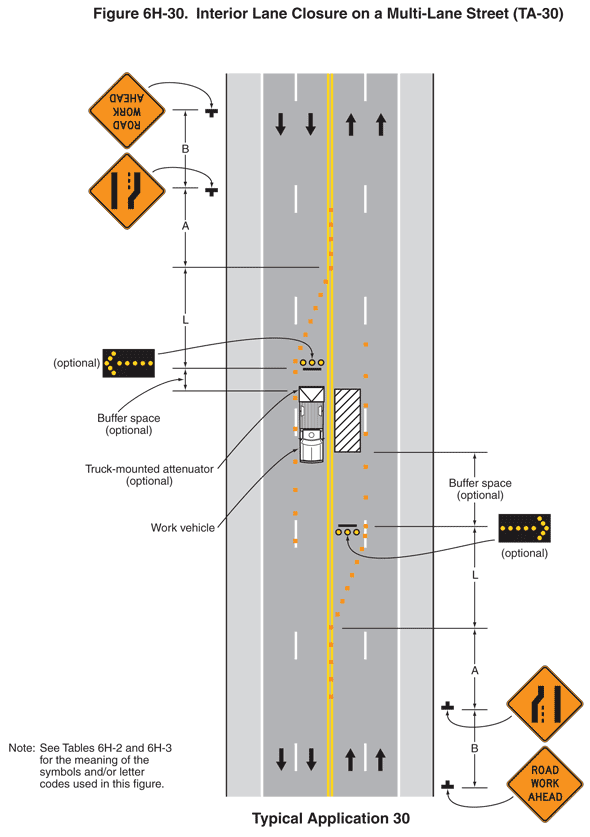2009 Edition Part 6 Figure 6H-30. Interior Lane Closure on a Multi-Lane Street (TA-30)

Figure 6H-30. Interior Lane Closure on a Multi-Lane Street (TA-30)
This figure illustrates an example of interior lane closure on a multi-lane street. A legend under the figure states that this is Typical Application 30. A note states "See Tables 6H-2 and 6H-3 for the meaning of the symbols and/or letter codes used in this figure."
This figure shows a vertical four-lane roadway with two lanes of traffic in each direction. Downward-pointing black arrows in the two left lanes and upward-pointing arrows in the two right lanes denote the direction of traffic. The opposing lanes are shown separated by a solid double yellow line. A shoulder is shown to the right of each right-hand lane. The shoulders are shown separated from the right lanes by a solid white line. The two lanes in each direction are shown separated from each other by a broken white lane.
At the bottom of the figure and to the right of the shoulder of the right, northbound lane, a black inverted "T" is shown denoting a sign. The sign is shown as a diamond-shaped orange sign with a black border and the words "ROAD WORK AHEAD" in black. Beyond the sign, at a dimensioned distance B, another sign is shown to the right of the shoulder. It shows a thick, vertical straight line on the right; a thick, vertical line on the left that angles toward the right half way up; and a thin, short vertical dotted line between them that is the length of the vertical section of the line on the left, denoting a lane ends. Adjacent to this sign, a series of orange squares is shown, denoting channelizing devices, beginning along the solid double yellow line. The devices are shown continuing along the solid double yellow line for a dimensioned distance A. From this point, the channelizing devices are shown tapering diagonally to the right for a dimensioned distance L to the broken white line dividing the two northbound lanes. At this point, a horizontal rectangular black arrow panel with a yellow directional arrow pointing to the right is shown in the center of the left northbound lane and labeled optional. Beyond this panel, a buffer space is shown and labeled optional in advance of a vertical rectangle with diagonal black and white stripes, denoting a work space. The channelizing devices are shown continuing along the broken white line for the length of the buffer space and to the right of the work space and for a short distance beyond the work space.
At the top of the figure for the left, southbound travel lane, the same series of a Road Work Ahead sign, lane ends symbol sign, channelizing devices, buffer space, and arrow panel is shown. In this direction, the arrow panel is shown in advance of a south-facing work vehicle with a truck-mounted attenuator labeled optional on the back. The truck is shown in the southbound left lane adjacent to the work space in the northbound left lane.
